Europa, the sixth moon of Jupiter, belongs to Jupiter’s orbit. It has an icy surface composed of water ice ranging from 10 to 30 km thick. Below this icy crust, there is a liquid ocean that extends 20 to 30 kilometers deep. Underneath the ocean, there is a thick layer of rocks, and at the center of the moon, there is a metallic core.
Europa orbits around Jupiter at a distance of 670,900 km and completes one orbit every 3.5 days, traveling at a speed of 50,000 km/h. It always faces the same side towards Jupiter. Although Europa is smaller than the Moon, it has a similar density. The moon is composed of silicate rocks, which gives it similarities to the planets in the Earth group.
The composition of Europa’s atmosphere includes molecular oxygen, but it is extremely rarefied. The level of rarefaction is so extreme that the pressure near the surface is approximately 1/1000000000000000th of Earth’s pressure.
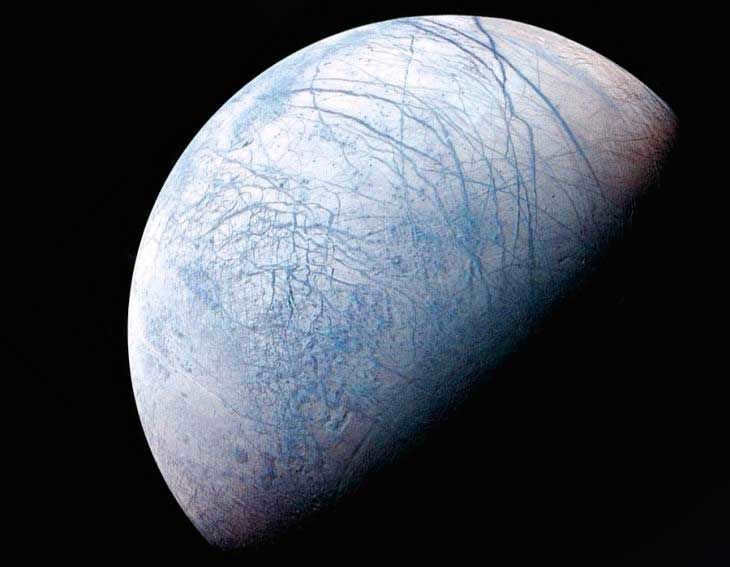
It is highly probable that this Jupiter satellite, similar to the other Galilean satellites, is formed from a disk of dust and gas surrounding the planet. The circular shape of the satellites’ orbits suggests this.
Europa’s Surface: A Unique Landscape
The surface of Europa is truly one-of-a-kind. It boasts an incredibly flat terrain, interrupted only sporadically by the presence of small hills that reach heights of approximately one hundred meters.
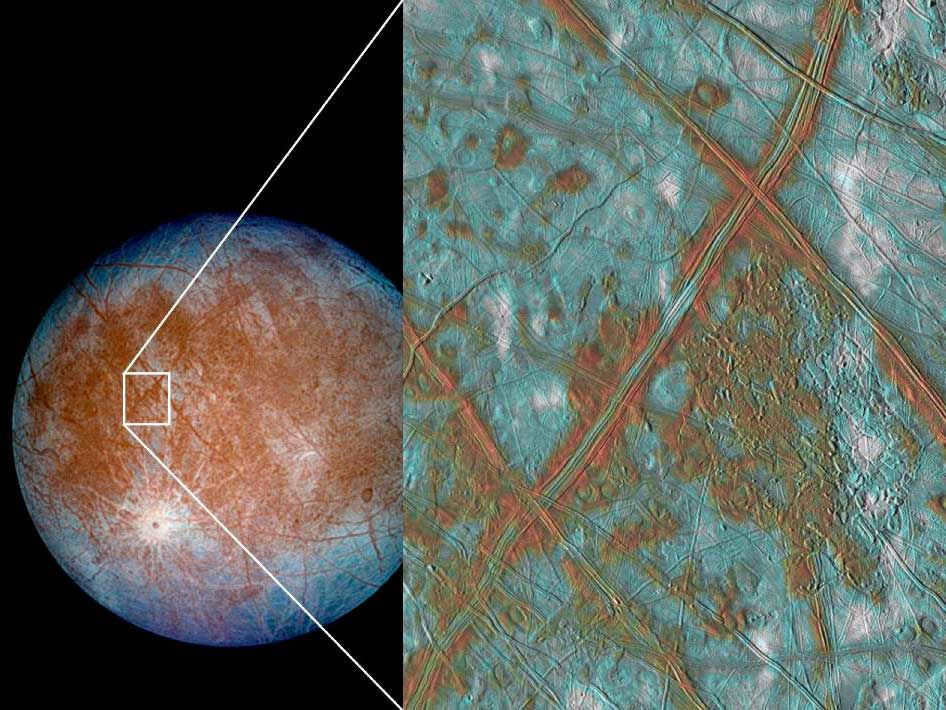
- Plains. These types of plains can form when cryovolcanoes erupt. Cryovolcanoes are volcanoes that erupt at extremely low temperatures, releasing ammonia, water, and methane compounds. These compounds fill in areas and solidify, creating plains.
- Chaotic areas. These areas are filled with random debris of various shapes.
- Areas composed of lines and streaks. These lines and streaks are cracks and fractures in the icy shell of the planet. They encircle the entire surface.
- Ridges. Ridges often have a double structure. They form when ice grows on the edges of cracks that open and close intermittently.
- Craters resulting from meteorite impacts.
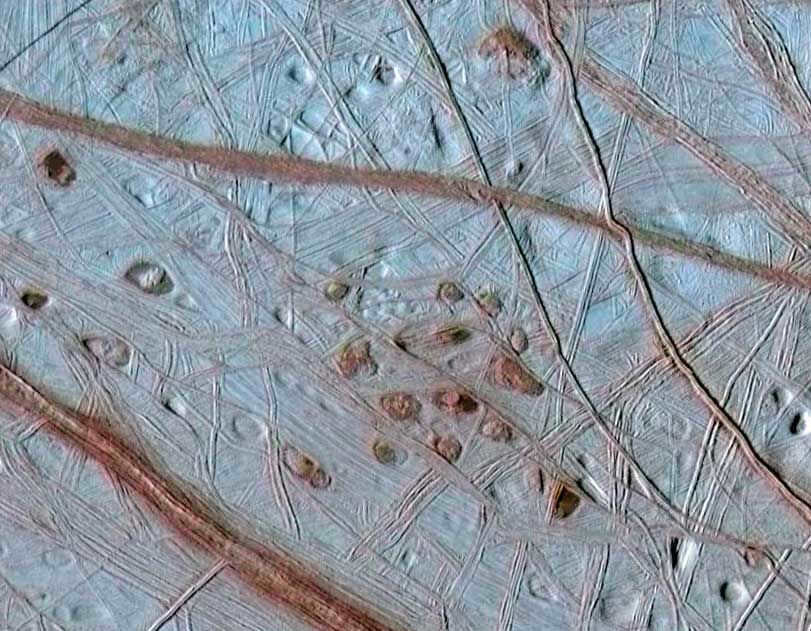
The surface of the planet is also comprised of salt elements, along with compounds of iron and sulfur. These components impart a reddish tint to the interior regions of the crevices.
Additionally, there are freckle-like features present. These formations have a dark appearance and can take on convex or concave shapes. It is hypothesized that they formed due to the interaction between heated internal ice and the colder external environment.
Ocean
The primary evidence suggesting the existence of an ocean beneath the ice is the detection of a magnetic field. A conductive layer, such as a saltwater ocean, is necessary for the generation of a magnetic field. Additionally, another indication of the ocean’s presence is the occurrence of an 80° shift in the planet’s crust. This shift would not have been possible if the crust had been firmly connected to the planet’s interior.

The formation of an ocean beneath Europa’s ice is attributed to the production of tidal heat resulting from the gravitational pull of Jupiter.
Researchers propose that the subglacial ocean engages in interactions with the surface ice, facilitating the exchange of gases and minerals. This suggests a diverse composition of water.
Could There Be Life on Europa?
Europa presents a real opportunity for discovering extraterrestrial life. While there are currently no direct indications of life, the existence of liquid water provides a glimmer of hope. There is a possibility that some form of microbial life may exist within Europa’s subsurface ocean. It is plausible that life forms could emerge around hydrothermal vents on the ocean floor. Additionally, it is conceivable for organisms to survive in an attached state, similar to algae, beneath the ice shell. The viability of life on Europa depends greatly on the temperature and salinity of its ocean. If the temperature is too low or the salinity is too high, the chances of any kind of life diminish significantly.
Regarding the availability of oxygen, it is considered to be favorable. According to calculations by Professor R. Greenberg from the University of Arizona, the ocean of Europe is adequately saturated with oxygen. He believes that this is sufficient for the emergence and functioning of certain life forms. Additionally, it is possible that microorganisms were brought to the planet by meteorites.
In 2013, there was a report about the discovery of hydrogen peroxide on Europa. This discovery presents a potential energy source for certain bacteria. Furthermore, traces of phyllosilicates, which are clay minerals originating from comets or asteroids, have been found, further increasing the likelihood of life existing.
The most optimal method of transportation across Europe is by utilizing an iceboat. However, a regular sail is not ideal for this purpose as the wind may not always cooperate. Consequently, we will modify a unique sail specifically designed to harness the power of the solar wind.
It is essential to ensure adequate protection from radiation for the enclosure of our buyer, as the radiation levels are extremely high in this location, with the potential to receive a lethal dose within minutes. The skids we use are designed to be long and wide to accommodate the rough terrain, as the surface of the planet is filled with cracks and fractures, similar to the rugged ice of Baikal.

Our journey begins as we unfurl the sail and start moving. The temperature today is at an average of -160°C, creating a frosty environment. The skids gracefully glide across the sturdy ice, gaining speed with every passing moment. It is crucial to remain vigilant and identify any cracks or hummocks that may appear. For a brief moment, one might forget our location and imagine being in the vastness of Antarctica, with the exception of the absence of any atmosphere.

Exploring Europa
- The Pioneer 10 and 11 stations were the first to photograph Europa in 1973-74. The first and second Voyagers then followed up with both pictures and research, leading to the hypothesis of a liquid ocean.
- In 1994, the presence of molecular oxygen in Europa’s atmosphere was detected by the Hubble telescope.
- From 1999-2000, the Chandra space observatory observed Europa and detected X-rays from the moon as well as Io.
- Between 1995 and 2003, intensive research was conducted on the planet by the Galileo autonomous probe, which managed to approach Europa’s surface at a distance of 201 kilometers. The probe discovered further indications of the existence of a vast ocean on the planet. In order to safeguard the planet from any potential contamination by terrestrial microorganisms, the probe was deliberately destroyed within Jupiter’s atmosphere.
- Subsequent to that, in 2007, during its mission to Pluto, the New Horizons spacecraft captured yet another image of the frigid planet.
There are multiple projects aimed at exploring Europa, each with its own set of objectives. These missions seek to investigate the chemical composition of Europa and search for signs of life in its vast ocean. It is important to note that all these endeavors are carefully designed to withstand the intense radiation levels on Europa, which are a million times higher than those on Earth.
One proposed solution to overcome the icy shell is the creation of an atomic melting probe, also known as the “Cryobot.” This innovative device would be capable of melting through the ice to reach the water layer below. Once in the water, another instrument called the “Hydrobot” would take over, collecting valuable data and transmitting it back to Earth.
In 2016, NASA allocated funding for the development of the Europa Clipper project, marking the official commencement of preparations for the Europa mission. This spacecraft is scheduled to launch in the 2020s.
The potential manifestations of both matter and life are beyond our imagination. Observing a glittering pearl in the vicinity of the radiant Jupiter through a telescope, it prompts us to ponder: could this be the abode of life?
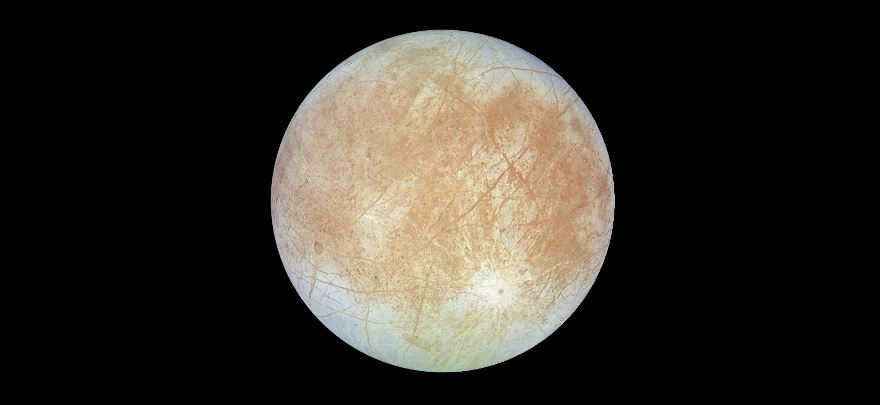
Europa: Facts about Jupiter’s Icy Satellite and Its Ocean
Europa is one of Jupiter’s satellites and is part of the Galilean group discovered by Galileo Galilei. This moon is named after its discoverer and is the smallest in size but the most visually striking. In this article, we will explore interesting facts about Europa, including its composition, the possibility of life, and future space missions.
Exploring Europa
For young readers, it is important to understand the significance of Europa as one of Jupiter’s moons. Parents and teachers can explain to children that Europa, along with three other moons, forms the Galilean group. This group was discovered by Galileo Galilei, a famous astronomer. Europa stands out for its icy surface and the potential for an ocean beneath its crust.
Composition and Potential for Life
Europa is primarily made up of rock and ice, giving it a unique appearance. Scientists believe that beneath its icy crust, there is a vast ocean of liquid water. This makes Europa one of the most promising places in our solar system to search for life beyond Earth. The ocean on Europa is believed to have a higher volume of water compared to Earth’s oceans.
Future Missions and Discoveries
In order to learn more about Europa and its potential for life, scientists and space agencies are planning future missions to this intriguing moon. These missions will involve sending spacecraft to orbit Europa and possibly land on its surface to gather more data. The goal is to study Europa’s composition, search for signs of life, and understand the moon’s geological activity.
As our knowledge of Europa continues to grow, so does our fascination with this icy moon and the possibility it holds for unlocking the mysteries of our universe.
The satellite is completely covered with ice, but scientists are of the opinion that there exists an ocean beneath the surface. The ice also makes Europa stand out as the brightest moon in our solar system due to its high level of solar reflection. Even though water trickles were observed by researchers in 2013, there have been no further sightings.
Pioneer 10 and 11 as well as Voyager 1 and 2 flew over Europa during the 1970s. Galileo extensively studied Jupiter and its moons from 1995 to 2003. Both NASA and the European Space Agency have plans to send a mission to Europa in the 2030s.
Fascinating Information about Europa – Explained for Children
- Age: Europa is as old as Jupiter, with a remarkable age of 4.5 billion years.
- Distance from the Sun: Europa is located at a distance of 780 million km from the Sun.
- Distance from its Planet: Occupying the sixth position from Jupiter, Europa orbits at a distance of 670,900 km. It completes one orbital revolution in 3.5 days. Moreover, Europa is tidally locked, meaning that one side of the moon always faces Jupiter.
- Size: With a diameter of 3,100 km, Europa is smaller than Earth’s Moon but larger than Pluto. It is the smallest among the Galilean satellites group.
- Temperature: The equatorial line of Europa never warms above -160°C. However, at the poles, the temperature drops even further to -220°C.
The exploration of Europa – an explanation for kids
According to historical records, Europa, one of Jupiter’s moons, was reportedly discovered by Galileo Galilei on January 8, 1601. However, it is worth noting that Simon Marius, a German astronomer, might have also discovered Europa around the same time, but he chose not to share his findings with the public. Interestingly, although these moons are commonly referred to as Galilean satellites, Galileo himself initially named them the Medici planets as a tribute to the influential Medici family.


This image depicts the hemisphere of Europa that was captured by the Galileo spacecraft when it was 677,000 kilometers away. The left side of the image displays the true color of Europa, while the right side is enhanced to emphasize the finer features. You can observe the Puyl crater, which measures 45 kilometers in diameter, in the lower right corner of the image.
The initial suggestions for names came from Marius, who was adamant about selecting figures from Greek mythology. However, it wasn’t until the 1800s that the satellites were officially named. One of these satellites, Europa, was an exquisite maiden who was abducted by Zeus. The Greek god assumed the guise of a magnificent white bull, adorned with vibrant blossoms, and carried Europa on his back to the island of Crete. It was there that she ascended to the role of queen and bore numerous offspring for Zeus.
Explaining Europe’s Unique Features to Children
Europe is known for its special qualities that make it stand out. One of the most interesting characteristics is its high level of reflection. Scientists measure this using a term called albedo, which is the amount of light reflected off a surface. In Europe, the albedo of the ice crust is an impressive 0.64, making it one of the highest values among all the moons in our solar system. This suggests that Europe has a relatively young surface, estimated to be between 20 and 180 million years old.
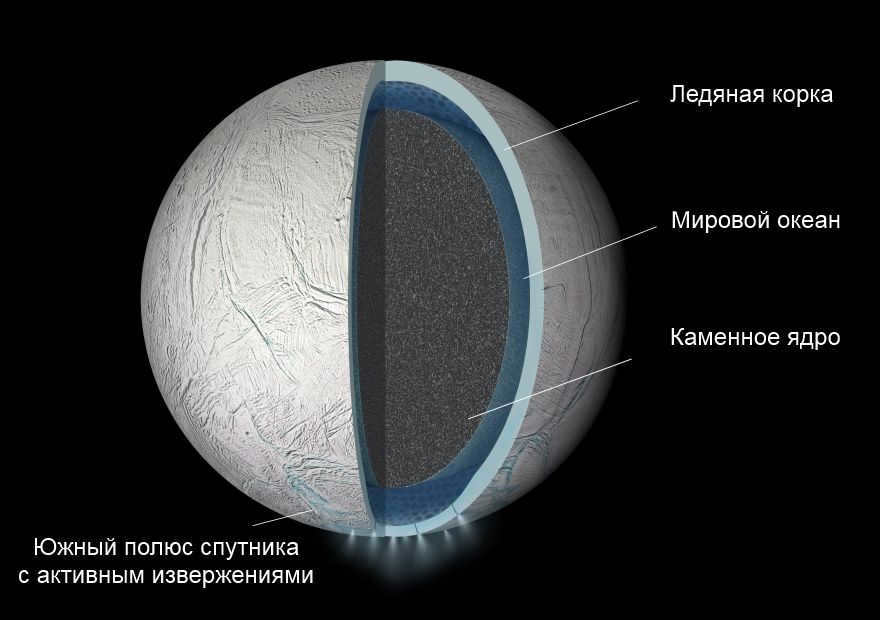
The composition of Europa is similar to that of Earth, with a silicate rock structure, an iron core, and a rocky mantle. However, what makes Europa unique is the presence of a water/ice layer (80-170 km) beneath its surface.
Scientists have discovered fluctuations in Europa’s magnetic field, suggesting the possible existence of an ocean. This has led to excitement among researchers, as there is a chance that this ocean may harbor life forms. As a result, scientists are dedicating significant attention to studying this moon.
There are numerous fissures on the surface. They are thought to be a result of the gravitational forces exerted by the subsurface ocean (as the moon approaches its orbit, the water level rises). Interestingly, it is not necessary to drill into the surface in order to retrieve samples. In 2013, the Hubble telescope observed geysers located at the southern pole. However, the geysers subsequently disappeared, leading to speculation about the potential cyclical nature of these formations.
In 2014, it was uncovered that the satellite may possess plate tectonics. Prior to this discovery, only Earth was known to have a dynamic crust.
Explaining to Kids: The Best Places to Look for Life on Europa
If you’re a young parent or a student, I can explain to you why scientists believe that Europa, one of Jupiter’s moons, is a very interesting place to look for signs of life. It is believed that beneath Europa’s icy surface, there is a huge ocean. This ocean might have openings in its mantle, similar to the oceans on Earth. These openings create a ventilation effect and provide the right conditions for life to exist. Scientists also think that life on Europa might have come from a comet impact. So, if we want to find extraterrestrial life, Europa is definitely a great place to start exploring!

The surface of Europa is adorned with intricate and captivating designs. To construct this illustration, information from the Galileo spacecraft during the years 1995 and 1998 was utilized.
A recent research conducted in 2016 revealed that the moon generates oxygen in a ratio of 10 to 1 compared to hydrogen. This characteristic makes the ocean more hospitable to various life forms. Additionally, the moon would not be dependent on tidal heating to generate the necessary energy. Chemical reactions would be sufficient to propel the cycle.
Exploring Europa in the Future – A Kid-Friendly Explanation
The exploration of Europa is something that scientists are very excited about and it is now a top priority. However, we will have to wait until the 2020s for this mission to become a reality. The spacecraft that will be sent to Europa will not only fly by the moon, but also have a number of scientific instruments on board to help us learn more about this fascinating place.
These instruments include cameras that will take pictures, radar that will help us understand the ice on Europa and how thick it is, a magnetometer that will measure the magnetic field, and a thermal sensor that will help us look for any eruptions that might be happening on the moon.
But that’s not all! The European Space Agency is also planning a mission to Europa’s neighbor, Jupiter, as well as two other satellites called JUICE. This mission is scheduled to launch in 2022 and will arrive at Jupiter in 2030. The goal of this mission is to study organic molecules and other components that could potentially be signs of life. They will also be measuring the thickness of the crust, especially in areas where there might be volcanic activity.
We hope that the information provided about Jupiter’s moon Europa has been helpful. When explaining this to children, it’s important to provide engaging facts, captivating photos, interesting videos, and colorful drawings to ensure that the learning process is both enjoyable and easy to comprehend. Additionally, children of all ages will be fascinated by our 3D model of the solar system, which includes a detailed map of Jupiter, its surface features, and its major moons. Although it is highly unlikely to directly observe Europa in real time using an online telescope due to its significant distance from Earth and relatively small size, some individuals claim to have witnessed it.
To discover more about Jupiter’s moons, please continue reading:
Europa, one of the four satellites of Jupiter, was first spotted by Galileo Galilei. Each of these satellites possesses its own distinct characteristics and fascinating attributes. In terms of proximity to the planet, Europa holds the sixth position and is regarded as the smallest member of the Galilean cluster. This moon exhibits an icy exterior and potentially harbors warm water. Hence, it is widely regarded as an ideal candidate for the exploration of extraterrestrial life.

Exploration and identification
In January 1610, Galileo observed all four celestial bodies through an enhanced telescope. Initially, he mistook these luminous spots for stars, but soon he discerned that they were actually the inaugural moons of an alien planet.

Jupiter’s icy moon Europa.
Europa was named after a Phoenician noblewoman and the lover of Zeus. She was the daughter of the king of Tyre and eventually became the queen of Crete. The name was proposed by Simon Marius, who claimed to have discovered the moons independently.
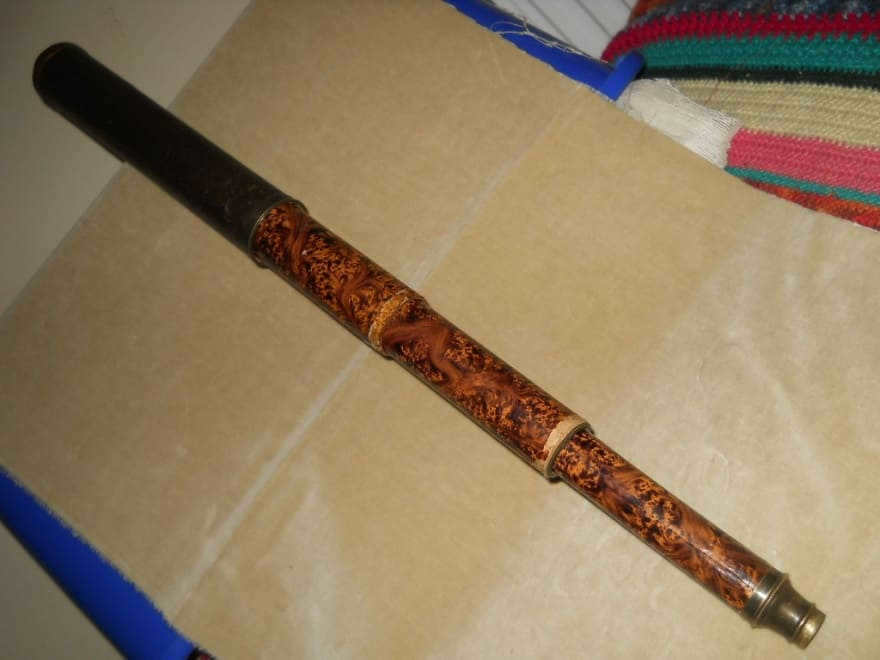
Galileo’s telescope featuring a handwritten record of the lens’s magnification capability
Galileo opted not to assign names to his satellites, instead using Roman numerals for identification. It wasn’t until the 20th century that Marius’ suggestion was reconsidered and gained popularity and official recognition.
The discovery of Almathea in 1892 resulted in Europa being demoted to 3rd place, and the Voyager mission’s discoveries in 1979 further demoted Europa to 6th place.
Dimensions, Mass, and Orbit
Jupiter’s moon Europa has a radius of 1,560 km (which is 0.245 times the radius of Earth) and a mass of 4.7998 x 10^22 kg (only 0.008 times the mass of our planet). Despite being smaller than our moon, Europa’s orbital path is nearly circular. It has an average distance from Jupiter of 670,900 km, but it can get as close as 664,862 km and move as far as 676,938 km due to its eccentricity value of 0.09.
A skilled tarot reader will provide answers to the following questions:
What does the future hold for you? How will your relationships unfold? What is the best course of action to take?

Similar to every entity within the Galilean cluster, it is subject to a gravitational constraint, causing it to have one side perpetually facing its primary. Nevertheless, it is plausible that this constraint is not absolute, and there exists a potential for asynchrony in its rotation. Discrepancies in the distribution of internal mass might result in the axial rotation of the celestial body being faster than its orbital rotation.

Comparison of the dimensions of the Earth, Moon, and Galileo’s satellites
The planet takes 3.55 days to complete an orbit and has a tilt of 1.791° in relation to the plane of the Earth’s orbit. There is a 2:1 resonance with Io and a 4:1 resonance with Ganymede. The gravitational pull from these two satellites results in oscillations in Europa. The proximity to and distance from the planet causes tidal effects.
Therefore, you have acquired knowledge about which planet Europa acts as a satellite of.
Main characteristics of Europa’s moon
The heating of the internal ocean and the activation of geological processes can be caused by tidal deformation resulting from resonance.
Composition and Surface
With a density of 3.013 g/cm 3 , Europa’s moon is composed of a rocky part consisting of silicate rock and an iron core. Above the rocky interior lies a 100 km thick layer of ice. This ice layer is likely separated by an outer crust and a lower liquid ocean. If the latter is present, it would be warm, salty, and contain organic molecules.
A skilled tarot reader will address the following inquiries:
What does the future hold for you? How will your relationships evolve? What is the right decision to make?

Europa is known for having one of the smoothest surfaces in the solar system. Its lack of mountains and craters is attributed to its young and active upper layer. Scientists estimate that the renewed surface of Europa is between 20 and 180 million years old.


An artistic depiction of chloride salts bubbling in Europa’s ocean
However, there are still small and noticeable 10-meter ice peaks (known as penitents) along the equatorial line, formed due to the effects of sunlight. These large formations stretch for 20 km and have dark edges scattered throughout, possibly resulting from the eruption of warm ice.
There is also a belief that the ice crust on Europa may rotate more quickly than its interior, potentially causing the surface to separate from the mantle. This behavior is similar to the movement of tectonic plates on Earth.
One can observe elliptically shaped lenticules, which are characterized by a range of domes, pits, and patches. The peaks bear a resemblance to ancient plains. It is possible that these formations were created as a result of meltwater reaching the surface, and the jagged patterns consist of tiny fragments of darker substance.
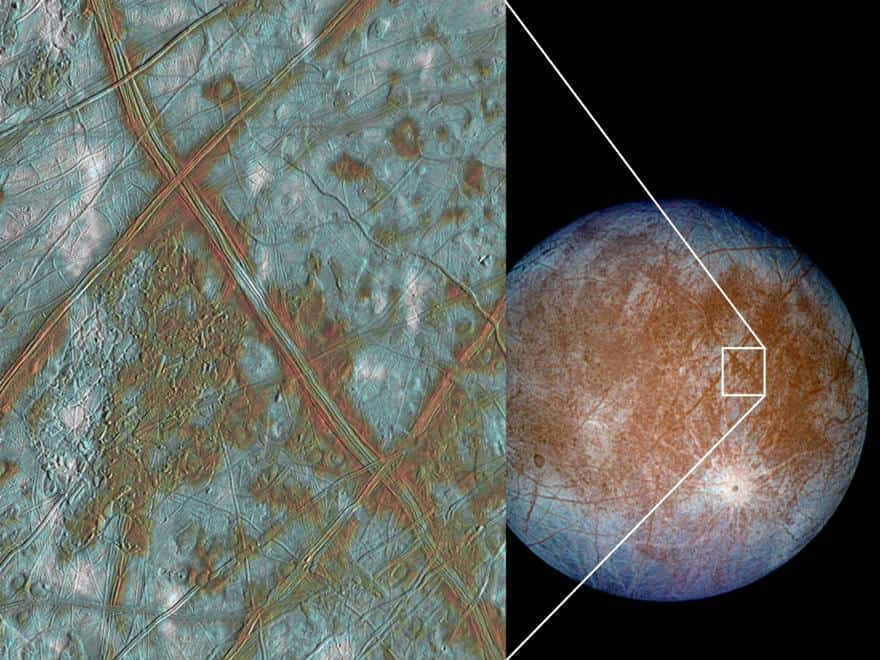

The Galileo mission was able to capture images of Europa, one of Jupiter’s moons.
During Voyager’s flyby in 1979, scientists were able to observe a reddish-brown material covering the faults on Europa’s surface. Further analysis using spectrograph revealed that these areas are rich in salts, which are believed to be deposited through water evaporation.
Europa’s ice crust has an albedo of 0.64, making it one of the brightest satellites in the solar system. However, the radiation levels on its surface are incredibly high, reaching 5400 mSv per day, which would be lethal to any form of life. The temperature also drops significantly, reaching -160°C at the equatorial line and -220°C at the poles.
Hidden Ocean Beneath the Ice Layer
A multitude of scientists strongly believe that a concealed body of liquid water exists beneath the icy surface. Numerous observations and surface formations provide suggestive evidence of its presence. Should this hypothesis be accurate, the hidden ocean would span an impressive 200 meters in depth.
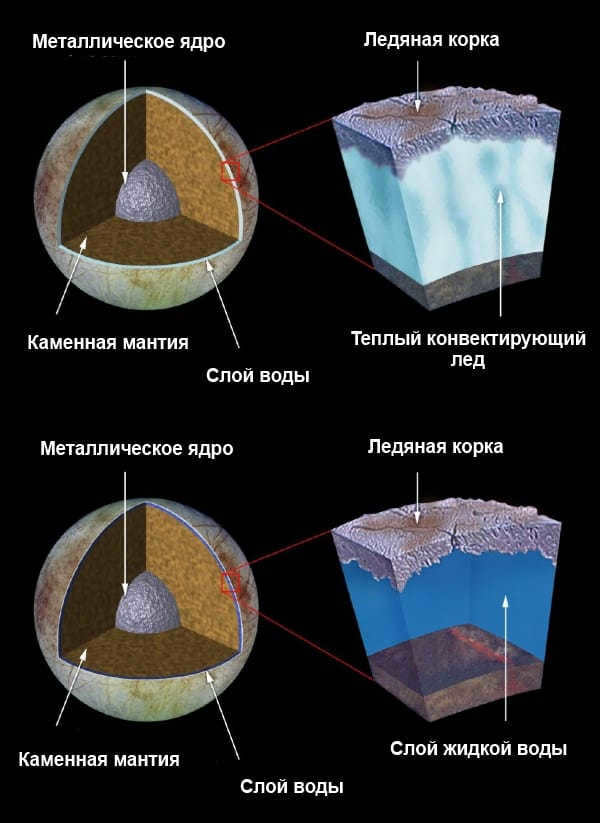

There are two models depicting the structure of Europa.
However, this is a debatable issue. Some geologists prefer a model with a thick layer of ice, where the ocean has minimal or no contact with the surface layer. This is supported by the presence of large lunar craters, which are surrounded by concentric rings and filled with fresh ice deposits.
The outer icy crust is estimated to be between 10-30 kilometers thick. It is believed that the ocean on Europa may encompass a volume of 3 x 10 18 m 3 , which is twice the amount of water present on Earth. The presence of the ocean was confirmed by the Galileo spacecraft, which observed a small magnetic moment induced by a changing part of the planetary magnetic field.
A knowledgeable tarot reader will provide answers to the following questions:

It has been periodically observed that water jets, reaching a height of 200 kilometers, which is 20 times higher than Earth’s Mount Everest, appear when the satellite is at its farthest distance from the planet. Similar phenomena have also been observed on Enceladus.
Atmosphere
In 1995, the Galileo spacecraft detected a thin atmospheric layer on Europa, consisting of molecular oxygen with a pressure of 0.1 micro Pascal. This oxygen is not of biological origin, but is formed through radiolysis, where UV rays from the planetary magnetosphere strike the icy surface and split water into oxygen and hydrogen.
An analysis of the surface layer revealed that some of the created molecular oxygen is retained due to the satellite’s mass and gravity. Since the surface is in contact with the ocean, oxygen can reach the water and activate biological processes.
A significant amount of hydrogen escapes into space, forming a neutral cloud. Within this cloud, nearly every atom undergoes ionization, creating a source of plasma for planetary magnetospheres.
Exploration
The first missions to explore Jupiter were Pioneer-10 (1973) and Pioneer-11 (1974). In 1979, the Voyager spacecraft sent back close-up photographs, including an image of Jupiter’s icy surface.
In 1995, the Galileo spacecraft began an 8-year mission to study Jupiter and its closest moons. One of the moons, Europa, caught the attention of scientists due to the possibility of a subsurface ocean, making it an intriguing object of study.
One of the mission proposals is the Europa Clipper. This spacecraft is designed to include a radar system capable of penetrating through the icy surface, a short-wave infrared spectrometer, a topographic thermal imager, and an ion-neutral mass spectrometer. The primary objective of this mission is to investigate the habitability of Europa.
In addition to the Europa Clipper, there are also plans for a landing vehicle and a probe that would be responsible for determining the extent of the ocean. Another mission concept, known as JUICE, has been in development since 2012 and aims to fly over Europa and conduct a thorough exploration of the moon.
Habitability
Europa, a moon orbiting Jupiter, holds great potential for the existence of extraterrestrial life. There is a possibility that life could thrive in its ocean or hydrothermal vents. Recent findings from 2015 reveal that geological features on Europa’s surface can be covered with sea salt, indicating that the liquid is in direct contact with the moon’s bedrock. This suggests the presence of oxygen in the water.
However, for life to flourish, the ocean must be warm, as our familiar life forms cannot survive in extreme cold. Additionally, high levels of salt would be detrimental. There are indications of liquid lakes on Europa’s surface and an abundance of hydrogen peroxide.
In 2013, NASA announced the discovery of clay minerals on Europa. These minerals could have originated from a comet or asteroid impact.
Colonization
Europa is perceived as an ideal candidate for both colonization and conversion due to its unique characteristics. Firstly, the presence of water on Europa makes it an incredibly valuable resource for potential colonists. While extensive drilling may be required, the abundance of water would serve as a crucial source for the colony’s needs. Furthermore, the vast inland ocean on Europa would also provide a source of air and rocket fuel, enabling the sustenance and advancement of the colony.
However, the colonization of Europa does come with its fair share of challenges. One notable obstacle is the immense radiation emitted by Jupiter, which poses a significant threat to the safety and well-being of any potential colonists. In order to mitigate this risk, it would be necessary for the colony to be strategically located beneath an ice sheet, providing a protective barrier against the harmful radiation. By utilizing rocket blasts and other methods to raise the temperature, the ice on Europa could be sublimated, forming a crucial atmospheric layer that would further support the sustainability of the colony.
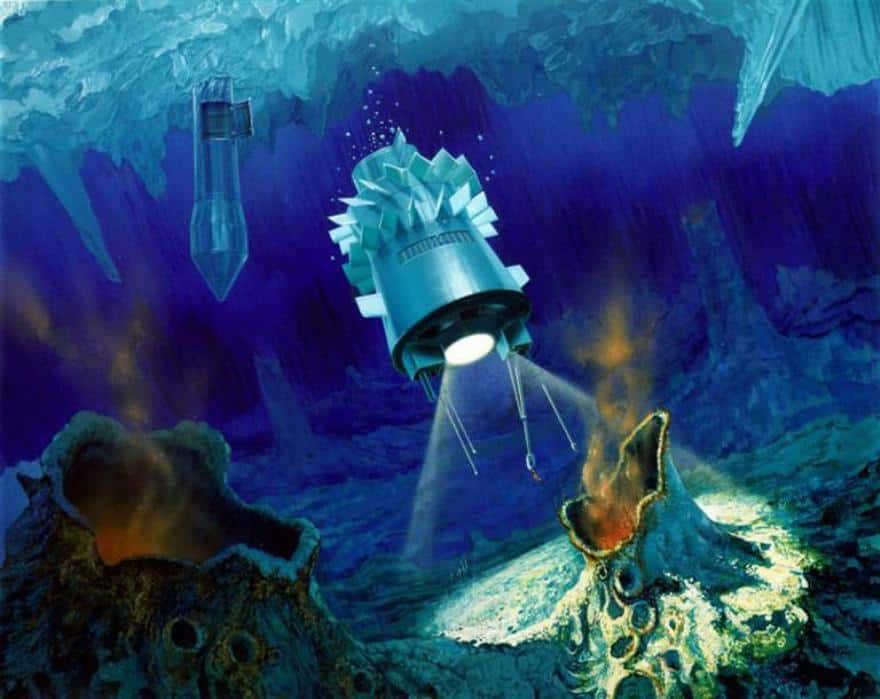
A concept of a cryobot designed for exploring the depths of the ocean.
Due to the low gravity, the crew will face physical weakness in the form of muscle atrophy and bone deterioration. Astronauts on the International Space Station already perform a special set of exercises to combat these effects, but the conditions on Europa would present even greater challenges.
Scientists believe that there may be organisms living on Europa. However, there is concern that introducing Earth microbes could disrupt the unique conditions and potentially harm the existing “inhabitants”.
While our focus is currently on colonizing Mars, Europa should not be forgotten. This moon holds immense value and possesses all the necessary conditions for supporting life. Therefore, after the initial probes, humans may one day journey to Europa. Let’s explore the surface of Jupiter’s moon Europa.
Map of the surface
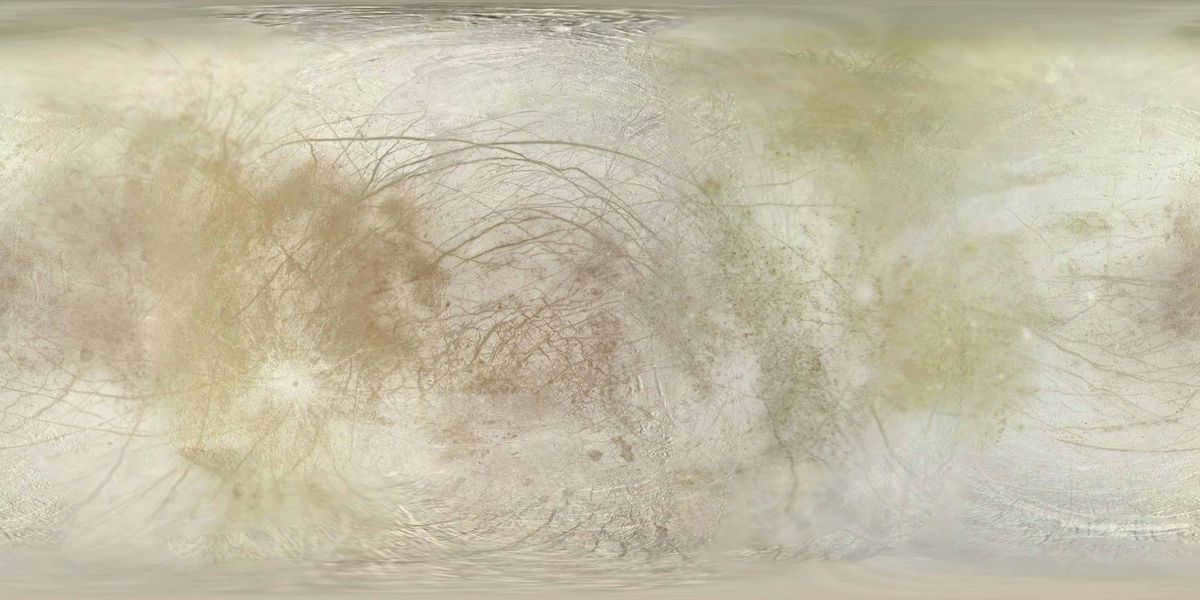
Click on the image to enlarge it
Europa (Greek. Ἐυρώπη ) is one of the four Galilean moons of Jupiter and is the smallest. It is believed to have a subsurface ocean beneath its icy crust, which could potentially harbor life.
Discovery and Naming
Europa was first observed by Galileo Galilei in 1610 using his telescope. However, German astronomer Simon Marius also claimed to have discovered Europa in 1609, but he did not publish his findings in a timely manner.
The name Europa was suggested by S. Marius in 1614, but it remained largely unused for a considerable period of time. Galileo referred to the four moons he discovered orbiting Jupiter as the “Medici planets” and assigned them ordinal numbers; he labeled Europa as “the second satellite of Jupiter”. It wasn’t until the mid-20th century that the name Europa gained widespread usage.
Physical attributes
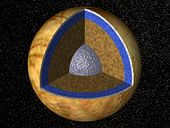
Europa, one of the largest moons in the solar system, is comparable in size to the Moon.
Europa is always facing Jupiter on one side. Io, Europa, and Ganymede are in a special orbital resonance, with their orbital periods related as 1:2:4.
Among the “icy satellites,” Europa resembles the planets in the Earth group more than the others. It is primarily made up of rock and is completely covered by a layer of water, estimated to be around 100 km thick. This includes an icy surface crust that is 10-30 km thick and a presumed subsurface liquid ocean. Beneath the water, there are rocks, and at the center, there is believed to be a small metallic core.
Europa’s Surface
The surface of Europa is remarkably flat, with only a handful of small hills that reach a maximum height of a few hundred meters. The satellite’s high albedo suggests that the surface ice is exceptionally pure, indicating its relative youth. It is believed that the cleaner the ice on the surface of “icy satellites,” the younger the surface is. Additionally, there are only three craters larger than 5 km in diameter, further supporting the idea of a relatively young surface. Scientists estimate that Europa’s surface is no more than 30 million years old, making it geologically active. Despite this, a comparison of photographs taken by the Voyagers and Galileo spacecraft over a 20-year period did not reveal any noticeable changes.
The temperature on the surface of Europa is extremely cold compared to Earth, reaching temperatures between 150-190 degrees Celsius below zero. Additionally, the surface of this moon experiences high levels of radiation due to its orbit passing through Jupiter’s intense radiation belt.
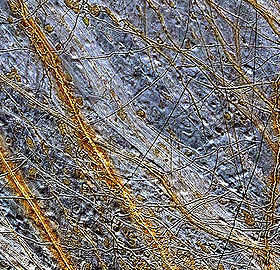
The surface of Europa displays a distinctive pattern of intersecting lines, which are actually faults and cracks in the ice shell. Some of these lines encircle the entire planet. Interestingly, this crack system bears a striking resemblance to the cracks found in the ice shell of Earth’s North Pole (as seen in comparative images of Earth and Europa).
Scientists believe that the surface of Europa is in a constant state of change, with new fractures continuously forming. The edges of these fractures can move independently, and occasionally, subsurface fluid can rise up through the cracks. Additionally, Europa features long double ridges (as shown in the image), which are believed to form as a result of ice growth along the edges of opening and closing fractures (as depicted in the ridge formation diagram).
Long strips covered with rows of parallel furrows can be observed on the surface of the satellite. These stripes have a light center and dark, blurred edges. It is thought that these streaks were created by a series of cryovolcanic water eruptions along the cracks. The dark edges of the stripes may have formed due to the release of gas and rock fragments onto the surface. Additionally, there are bands of a different kind (refer to the image) that are believed to have formed when two surface plates moved, causing a crack to be filled with material from inside the satellite.
It is evident from the relief of certain regions on the surface that these areas were previously in a state of complete liquefaction, with the presence of ice floes and icebergs drifting in the water. The ice floes, which are now embedded in the frozen surface, were once interconnected and subsequently disengaged and turned.
Convex and concave formations resembling dark “freckles” (refer to the image) have been discovered. These formations may have been created through processes similar to lava outpourings, where warm, soft ice moves upward from the lower part of the surface crust due to internal forces, while cold ice settles downward. This discovery provides further evidence of a liquid, warm ocean beneath the surface. Additionally, there are larger, irregularly shaped dark spots (refer to the image) which are believed to have formed either from the melting of the surface due to ocean tides or the release of internal viscous ice. These dark spots can potentially be used to analyze the chemical composition of the inner ocean and shed light on the possibility of life existing within it in the future.
Furthermore, there are areas with a wavy surface, likely formed as a result of compression processes within the ice shell.
On the surface, there is a Pwill crater as well (refer to the photo), with a slide in the middle that surpasses its edges in terms of height (refer to the reconstruction). This could potentially suggest the release of soft ice or water through the hole created by the meteorite impact.
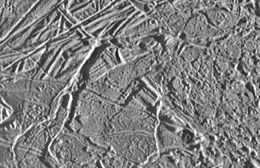
This area, measuring 10×16 km, displays a variety of landscapes: a disordered region on the right, fragmented ridges on the upper left, small craters, and a branching formation with an unclear geological origin.
The landscapes found in Europe can be categorized into the following primary types:
- Plains areas. Smooth plains can be created by cryovolcanoes that erupt and spread water across vast expanses.
- Disordered areas that resemble randomly scattered pieces of debris in different shapes.
- Areas dominated by lines and stripes.
- Ridges (typically consisting of two parallel ridges).
- Craters.
The characteristics discussed above suggest that there may be a liquid ocean beneath the icy crust on the surface of Europe. This ocean is estimated to have a depth of up to 90 km and a volume larger than that of Earth’s world ocean. It is believed that the heat necessary to maintain this ocean in a liquid state is generated by tidal interactions, with tides raising the surface of the moon by as much as 30 meters. However, there is another theory that proposes the presence of a soft ice layer instead of a liquid ocean to explain the nature of Europe’s surface.
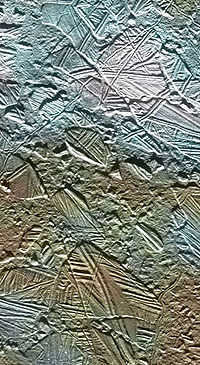
This particular region, characterized by the presence of “frozen ice floes,” serves as evidence for the potential complete thawing of certain areas on the surface in the past.
The existence of an underground ocean is confirmed by the fluctuating nature of Europe’s magnetic field. If the field was generated by a ferromagnetic core, it would be much more stable and weaker. The magnetic poles are positioned near the satellite’s equator and constantly undergo shifts. The variations in field strength and orientation align with Europa’s traversal through Jupiter’s magnetic field. This phenomenon can only be explained by the presence of a conductive fluid (such as water) beneath the satellite’s surface: Jupiter’s intense magnetic field induces electric currents in Europa’s salty ocean, which in turn generate its peculiar magnetic field.
An analysis of the dark lines and spots on the surface revealed the presence of salts, specifically magnesium sulfate, also known as “English salt.” The reddish hue indicates the existence of sulfurous and ferrous substances as well. Evidently, these salts are present in the ocean of Europe. Furthermore, traces of hydrogen peroxide and potent acids were detected.
It is hypothesized that the subglacial ocean of Europe bears similarities to parts of Earth’s oceans near deep-sea geothermal vents, as well as subglacial lakes like Lake Vostok in Antarctica. It is possible that life could thrive in such bodies of water. However, some scientists argue that Europa’s ocean could be quite toxic, making it less hospitable for organisms.
Besides Europa, there are believed to be oceans on Ganymede and Callisto (based on their magnetic field structures). However, calculations show that the liquid layer on these moons starts deeper and has a temperature significantly below freezing (although the water remains liquid due to high pressure).
The discovery of a water ocean on Europa has important implications for the search for alien life. Since the ocean is kept warm not primarily by sunlight but by tidal heating, this means that a nearby star is not necessary for the existence of liquid water, which is essential for the emergence of life based on proteins. Therefore, conditions for the development of life could exist in the outer regions of star systems, close to small stars, and even far from stars, such as in planetary systems.
Europa’s Atmosphere
Scientists using the Galileo spacecraft have made a remarkable discovery – Europa, one of Jupiter’s moons, has an ionosphere, suggesting the presence of an atmosphere. But it wasn’t until the Hubble orbiting telescope took a closer look that we could confirm the existence of this incredibly faint atmosphere. With a pressure of less than 1 micropascal, Europa’s atmosphere is extremely weak. It mainly consists of oxygen, which is produced when sunlight breaks down ice into hydrogen and oxygen. The low gravity on Europa causes the lighter hydrogen to escape into space.
Exploring Europe with Spacecraft
The Pioneer 10 station captured the first ever photographs of Europa from space when it passed by Jupiter in December 1973. These images provided a higher quality view of Europa compared to what telescopes could capture at that time.
In March 1979, Voyager-1 conducted a flyby of Europa, capturing high-resolution images and collecting data from a maximum distance of 732 thousand km. Voyager-2 followed suit in July, coming as close as 190 thousand km to the satellite. These spacecrafts provided valuable information and images of Europa, leading to the hypothesis of a liquid ocean on the satellite.
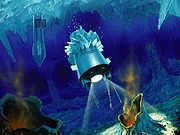
In recent years, there have been several exciting spacecraft projects aimed at studying Europa. One such project is the ambitious Jupiter Icy Moons Orbiter, originally planned as part of the Prometheus program to create a nuclear-powered, ion-propelled spacecraft. Unfortunately, this plan was scrapped in 2005 due to insufficient funding. Currently, NASA is focused on the development of the Europa Orbiter project. The goal of this project is to launch a spacecraft into Europa’s orbit to conduct detailed studies of the moon. It is expected that the launch could take place within the next 7-10 years, and there is a possibility of collaboration with the European Space Agency (ESA), which is also working on projects related to the exploration of Europa. However, as of 2006, there are no concrete plans for funding and implementing this project.
According to L. M. Zeleny, the head of the Space Research Institute, European and Russian scientists have plans to send a fleet of spacecraft to Jupiter and Europa. The mission will involve the launch of two spacecraft into the orbits of Jupiter and Europa, but Russian scientists have suggested adding a third spacecraft that will descend and land on the surface of Europa. This descent vehicle will target one of the faults in the planet’s multi-kilometer layer of ice. Once landed, the vehicle will melt a layer of ice measuring half a meter and initiate a search for basic forms of life. The project, named “Laplace,” is set to be included in the European Space Agency’s program from 2015 to 2025. Russian scientists from the Space Research Institute, NPO Lavochkin, and other Russian space organizations have been invited to participate. [1] [2]
Europe portrayed in literature, films, and games
- Europe holds significant significance in Arthur C. Clarke’s book 2010: Odyssey Two and its film adaptation directed by Peter Hyams. In the story, extraterrestrial beings aim to expedite the development of primitive life forms found in Europa’s subglacial ocean by transforming Jupiter into a star. In Clarke’s sequel “2061: Odyssey Three,” Europa is depicted as a tropical aquatic planet.
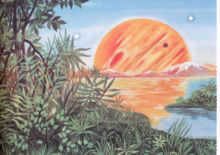
- Bruce Sterling’s “Schismatrix” depicts Europe as a desolate “frozen” planet with a barren inner ocean. One of the human civilizations that have expanded throughout the solar system decides to relocate to Europa. They establish a self-contained ecosystem on the moon and genetically modify humans to thrive in Europa’s aquatic environment.
- In Greg Beer’s narrative “God’s Forge,” Europa is annihilated by extraterrestrial beings who utilize its ice to transform habitats on other celestial bodies.
- Dan Simmons’ novel “Ilion” portrays Europa as the dwelling place of one of the sentient machines.
- Ian Douglas’ novel “The Battle for Europa” presents Europa as the site of a valuable extraterrestrial artifact that American and Chinese forces are vying to acquire in the year 2067.
- “Outlaws of Europa” by Michel Savage portrays Europa as a massive prison encased in ice.
- In the computer game “Infantry,” players can explore cities hidden beneath the icy surface of Europa.
- The game “Battlezone: Europe” presents Europa as a frigid battleground where the United States and an imaginary Soviet Bloc compete for dominance.
- In “Abyss: Incident at Europa,” players navigate a submarine base in the depths of Europa’s ocean.
- One episode of the anime “Cowboy Bebop” features the crew of the spaceship “Bebop” landing on Europa, which is depicted as a quaint planet with a small population.
- In addition to the artwork, there are some incredibly imaginative concepts for colonizing Europe. Specifically, the Artemis project ([1], [2], [3]) proposes utilizing igloo-like structures or establishing bases on the inner surface of the ice crust, creating “air bubbles” there. Additionally, submarines are envisioned for exploring the ocean. Furthermore, political scientist and aerospace engineer T. Gangale has even devised a calendar for Europan colonists (refer to [4]).





